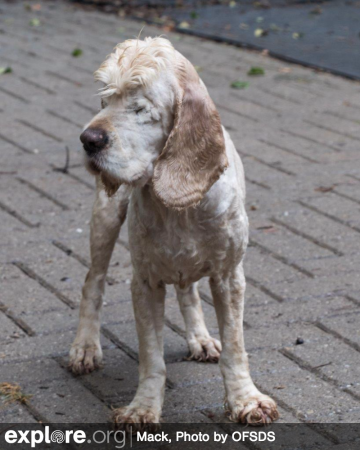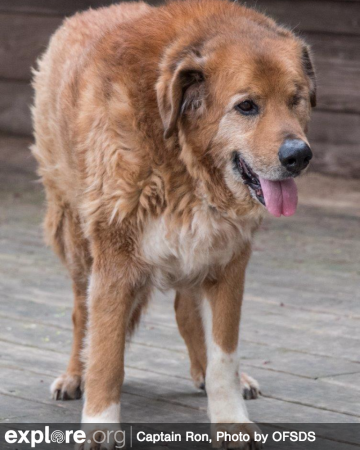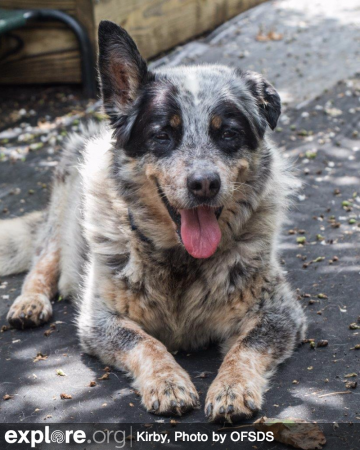Senior dogs go hand in hand with vision and hearing impairment. Most seniors have declining vision and hearing, and some lose one or both senses entirely. If you were to guess, what would be the worst of the two? Had you asked me a few years ago, I would have said, without a second thought, that the blind dog is much worse off…First let me talk about each disability separately, then I’ll comment on the comparison.
It is important to compare the level of “importance” a dog places on their senses compared to a human. The dogs most important sense is the sense of smell, followed by hearing and then sight. This is opposite to a human’s senses. Compare a dog losing their sight to us losing our sense of smell…. A dog doesn’t fully identify us or one another by sight, rather by smell.
We currently have many completely or nearly completely blind Old Friends here at the Sanctuary and in the Home Gang; Mack, Florence, Sherie, Ponce de Leon, Jake, Jeff and Mildred just to name a few. There are also several in our Forever Foster Homes. You’d never know it. We also have a few dogs whose vision is getting more and more impaired as they age. They are more obvious because they react to movement that they cannot identify. You will sometimes see a vision impaired (though not blind) dog jump back at a perceived danger. We have had many more blind dogs in the past. Some of them came here with full vision and it was not obvious that they had ultimately become completely blind. It was probably months before we realized that our Ozkar, a diabetic Keeshond and our first blind dog, was completely blind. He went through his normal routines and navigated the yard and house flawlessly. Dogs with suddenly acquired blindness will have more trouble adapting initially, but they will adapt. Bambi, a Golden Retriever who lost her vision over a period of weeks due to SARDS, had a difficult time getting used to her new home. She was not accustomed to using just her other senses to identify her space. Over a short period of time, she adapted well and would run circles through the fenced yard. Dogs have different ways of dealing with their blindness. Sherie walks with her nose to the ground using smell and her whiskers to identify her location, Mack finds his way by locating and following landmarks through the yard and and sanctuary. Since sight is not the primary sense for dogs (it is behind both smell and hearing) it is not as big of an issue to them to deal with as it would be for a human. They will compensate with their other, stronger senses. They communicate easily with the other dogs using smell and sound, and since they don’t create inappropriate eye contact, they don’t generally get into a lot of disagreements. The only time that our blind dogs are obviously blind are when they get into an excited mood and their instincts take over their thoughtfulness.
There are several things that you can do to make life easier for your blind dog.
1. Let them get used to the lay of the land and don’t move things too often. If you do move things, show them the changes so that they can get used to the new arrangement before they run into things. If they do end up running into something new, don’t worry, they will adapt.
2. Don’t baby the dog. He or she will figure things out and will be able to live a normal life. We are not fans of the collars and halos that are used to keep a dog from bumping into things. The halos limit the ability of the dog to use their whiskers and nose to navigate their surroundings. They are still going to bump into things with the halo but will not have the ability to easily identify the object to avoid it in the future. I am always so impressed at how well a dog will eventually adapt to their blindness that I have never been even tempted to get any extraneous apparatus.
3. Talk to your blind dog as you approach them. Let them know you are coming before you touch them.
4. Block off any stairs, large drops or other potential dangers. There are a lot of baby gates made for the tops and bottoms of stairs. Make sure that the dog can’t wander out of the door into an unfenced/unrestricted area. They can wander off and find themselves in danger that they are unable to see. Small steps are ok, if the dog can’t hurt themselves by going over them. We had a blind and deaf Springer Spaniel, Biscuit, several years ago. She knew that there was a short wall, about a foot high, around a tree. She would go up the wall, find the edge and FLY off the wall onto the ground below. She would go around in circles doing this again and again…
5. If other dogs are bothered by the blind dog bumping into them, or if the blind dog is easily startled by the other dogs, put a cat bell on the other dog’s collar. That will give some understanding of who is coming at the blind dog, or will give them a chance to get out of the way. This especially works well when there are more than one blind dog in the family. We have used this trick in the past, but have not found it necessary with the group we have now
We’ve had even more deaf dogs than blind ones. A certain level of deafness is present in most senior dogs. Several of our seniors are completely hard of hearing. These are Captain Ron, Zebbie, Kirby and Layla. Others seem to have some level of hearing loss and some of the others just don’t listen. Dogs with hearing loss startle easily when touched if they did not see someone coming. This can sometimes lead to snapping out or otherwise impulsively lashing. out.
Deafness often causes troubles when dealing with other dogs. Many of the warning signals that dogs give one another are verbal. The deaf guys don’t pay any attention. A deaf dog can be very confusing to his siblings. Imagine being in a room and you want to leave and go to another room.
Someone is leaning in the doorway. Normal behavior would be to say, “excuse me” and the other person would say, “no problem” and politely get out of the way… but what if things didn’t happen that way because they didn’t hear you?
Next, you would raise your voice, get a little more agitated and project a more aggressive tone… Hey! Get out of my way!! (sort of a growl)
If that didn’t work, you might give a little shove…. you get the picture….and dogs are not necessarily as polite as people are. We don’t usually bite.
Here are a few tips for living with deaf dogs.
1. Try not to startle them. They startle much more easily than do blind dogs and may react by snapping or bolting. Stomp a bit as you approach, so that they can “feel” you coming and gently touch them if they are not looking your way. Don’t forget that dogs rely more on hearing than sight, so if they can’t hear you it is more disturbing to them than not seeing you.
2. Use lots of hand signals. I feel like the guy at the airport helping the planes to park with some of the deaf dogs in our family. Kirby reacts very well to big arm waves. Zebbie does better with smaller gestures, otherwise he tends to come at you like a speeding boulder. Large gestures look like yelling to him.
3. Watch the deaf dogs, especially initially, with the other dogs in the family. Sometimes it takes them a while to get beyond the language barrier, and sometimes they never do. We had the sweetest senior golden retriever, Rosie, who was deaf as can be. She got along fine with everyone, but, when we got a foster dog, and he couldn’t communicate with her, he took it badly and jumped on her. This happened more than once, and we separated them. Luckily, the foster dog moved on in a few weeks. He had no problems at all with dogs who could hear his warning signals.
Deaf dogs often tend to have very loud or obnoxious barks. They can’t hear themselves…
Dogs who are blind and deaf such as Ponce de Leon and Tempe live in their own little worlds. This is not to say that they can’t be happy. They enjoy touch, learn where things are and can lead a perfectly happy life. Even though they are deaf, they seem to relate to the other canines like a blind dog would and “float” among their brothers and sisters. Daisy Mae, who was part of our family a few years ago, was potty trained, went outside on her own through the doggy door and loved to find sleeping companions to snuggle up to. She didn’t like Missy and yelled at her often.
Now, when you ask me what is more difficult for a dog to live with, blindness or deafness, I would immediately reply deafness, because now, after observing so many of each, I know.
Dogs are amazingly adaptable. They don’t spend time wondering “why me?” and worrying about their disabilities. They move past them. Their other senses become more acute and they learn how to live within their environment with what they are given. We can learn so much from our dogs……
Tune in here every week for more blog posts by Old Friends Senior Dog Sanctuary!









